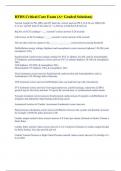HFHS Critical Care Exam (A+ Graded Solutions)
Normal Length for PR, QRS, and QT intervals. correct answers PR 0.12-0.20 sec, QRS 0.08-
0.12 sec, and QT interval less than or = to 450 ms or half the R-R interval
Big box on ECG readings = ___ seconds? correct answers 0.20 seconds
Little boxes on ECG readings = ____ seconds? correct answers 0.04 seconds
The mA that achieves capture is the _______ _________ correct answers pacing threshold
Defibrillation energy settings (biphasic and monophasic) correct answers biphasic 120-200 j and monophasic 360 j
Synchronized Cardioversion energy settings for SVT or aflutter, for afib, and for monomorphic VT (biphasic and monophasic) correct answers SVT or aflutter-biphasic 50-100 j & monophasic 200 j Afib-biphasic 120-200 j & monophasic 200 j Monomorphic VT-biphasic 100 j & monophasic 100 j
Vtach treatment correct answers Synchronized cardioversion and Antiarrhythmic such as Amiodarone (150-300 mg) and/or lidocaine
Vfib treatment correct answers Defibrillation also can load them up with Amiodarone
SVT treatment correct answers Vasovagal maneuvers, carotid massage, Adenosine (if BP is good) 6 mg for first dose and then 12 mg for the second dose, or synchronized cardioversion
Torsades treatment correct answers Synchronized cardioverison (if regular) or defibrillation (if irregular) and administer Mg (treating underlying cause)
Anatomical location of Cardiac Assessment Landmarks correct answers Pulse pressure calculation correct answers Difference between the systolic and diastolic pressure for example 120/60 the pulse pressure is 60!
Cardiac output normal values correct answers 4-8 Liters per minute (formula is Stroke Volume x
Heart Rate)
Cardiac Index normal values correct answers 2.5-4 L/min/m2 (formula is Cardiac output divided by Body Surface Area aka need ht and wt)
Central Venous Pressure or Right Atrial Pressure normal values correct answers 2-6 mmHg or 2-
8 cm H2O Pulmonary Arterial Pressure (PAP) normal values correct answers Pulmonary Artery Systolic (PAS) 15-30 mmHg
Pulmonary Artery Diastolic (PAD) 5-15 mmHg
Pulmonary Artery Mean (PAM) 9-18 mmHg
Pulmonary Artery Occlusion Pressure (PAOP) AKA Wedge normal values correct answers Similar to CVP or RAP and the diastolic pulmonary artery pressure will reflect this value closely... PAOP 6-12 mmHg
Systemic Vascular Resistance (SVR) normal values correct answers 800-1200
Ejection Fraction normal value correct answers 65-75%
SVO2 normal values correct answers 60-80
PA Pressure considerations correct answers Measure PAS and PAD @ the end of expiration
Causes of decreased PAP, CVP/RAP, PAOP correct answers causes of decreased Hypovolemia and venodilation
Causes of increased PAP correct answers hypervolemia, increased peripheral vascular resistance (due to decreased PaO2, PE, COPD, ARDS, Pulm HTN), mitral stenosis/insuff, aortic stenosis, LV ischemia, infarct, failure, pericardial tamponade, increased intrapleural pressure due to PEEP, auto PEEP, tension pneumo, increased intra-abdominal pressure, left-to-right intracardiac shunt.
Causes of increased CVP/RAP correct answers Hypervolemia, impedance to RA emptying due to: tricuspid stenosis, RV ischemia/infarct/failure, increased PVR (due to decreased PaO2, PE, COPD, ARDS, Pulm HTN), mitral stenosis/insuff, Aortic stenosis, LV ischemia/infarct/failure, pericardial tamponade, increased intrapleural pressure due to: PEEP, auto PEEP, tension pneumo, and increased intra-abd pressure
Causes of increased PAOP correct answers Hypervolemia, impedance to LA emptying: Mitral stenosis/insuff, aortic stenosis, LV ischemia/infarct/failure, & pericardial tamponade. increased intrapleural pressure due to: PEEP, auto PEEP, tension pneumo, intra-abd HTN. Left-to-right intracardiac shunt
Swan-Ganz catheter Ports & where they terminate correct answers Which port of a Swan Ganz catheter do you draw a SvO2 sample from? correct answers the tip of the Pulmonary artery catheter
Causes of increased SvO2 (Increased O2 delivery) correct answers Hyperchloremia: hyperdynamic septic shock, inotropic support/IABP, fluid volume replacement, afterload reducing agents. Increased SaO2: PEEP and increased FiO2




